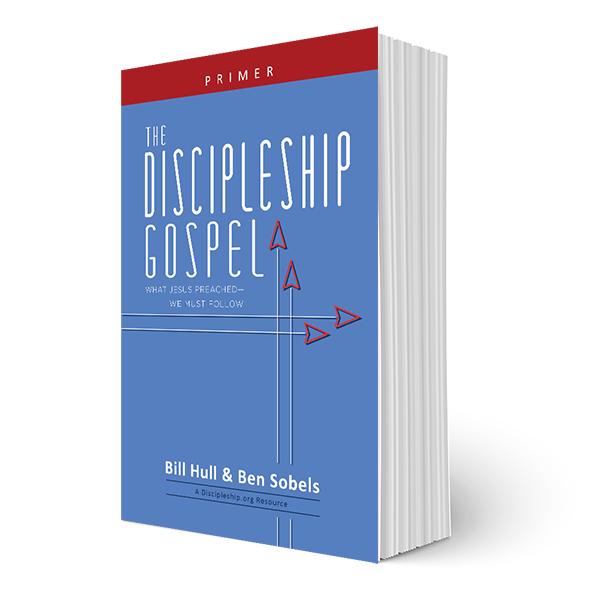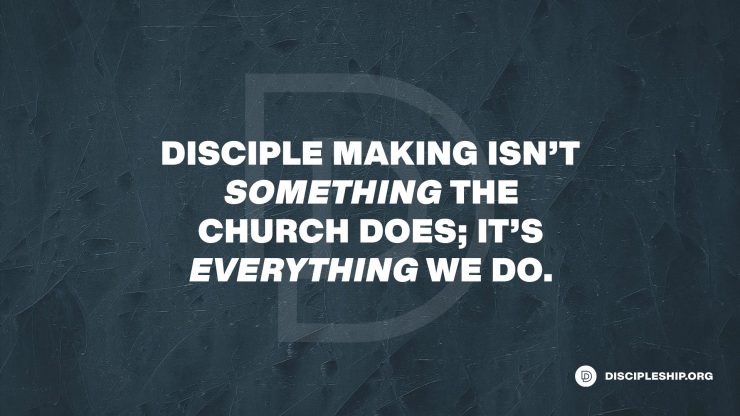The Seven Elements of Jesus’ Gospel
This blog is an excerpt from the free eBook, The Discipleship Gospel Primer. Download it free here.
“My plea is that we go back to the New Testament to discover all over again what Jesus’ gospel is.”1
—Scot McKnight
When we speak of the gospel that Jesus preached, it’s critical that we examine the New Testament Gospels because Matthew, Mark, Luke, and John are inspired records, which reveal Jesus’ gospel to us. While we could use any of the four Gospels, we have chosen to use Mark’s Gospel for the purposes of this book. Biblical scholars generally accept that Mark wrote his Gospel before the others, giving us the first written record of Jesus’ life and teachings.2 Another reason, and more to the point, is Mark’s Gospel reveals the gospel that Jesus preached in two specific passages: Mark 1:14-17 and Mark 8:27-31. These two passages make it clear that there are seven elements essential to Jesus’ gospel. Each of the seven elements is not only imbedded with discipleship, but also leads to it. In this chapter, we’ll start by examining Mark 1:14-17, where we discover four essential elements of the gospel Jesus preached.
Four Elements in Mark 1:14-17
In Mark’s Gospel, Jesus began his public ministry by preaching the gospel. We find this account in Mark 1:14-17. As you will see, these four verses are extremely important for understanding Jesus’ gospel. Their specificity is rare in the four Gospels. Generally, the Gospel writers tell us that Jesus preached, not what he said.3 Pay careful attention to what Jesus says:
Now after John was arrested, Jesus came into Galilee, proclaiming the gospel of God, and saying, “The time is fulfilled, and the kingdom of God is at hand; repent and believe in the gospel.” Passing alongside the Sea of Galilee, he saw Simon and Andrew the brother of Simon casting a net into the sea, for they were fishermen. And Jesus said to them, “Follow me, and I will make you become fishers of men.” And immediately they left their nets and followed him. And going on a little farther, he saw James the son of Zebedee and John his brother, who were in their boat mending the nets. And immediately, he called them, and they left their father Zebedee in the boat with the hired servants and followed him.4
Before we consider the elements of Jesus’ gospel in this passage, first take note that verse 14 expressly states that Jesus was “proclaiming the gospel.” It couldn’t be clearer—this is a gospel passage. In other words, Jesus reveals four elements of his gospel. People may say all kinds of things are part of the gospel by proof-texting and taking Bible verses out of context. Because it actually says that Jesus was “proclaiming the gospel,” Mark 1:14-17 is different.
This blog is an excerpt from the free eBook, The Discipleship Gospel Primer. Download it free here.
Content and Call
The four elements of the gospel revealed in Mark 1:14-17 are: God’s kingdom is here, repent of sin, believe the gospel, and follow Jesus. These four elements fall into two categories: content and call. The content of Jesus’ gospel, at this point, was exclusively about the kingdom of God. The call of Jesus’ gospel involved repentance, belief, and following Jesus. (We will discover three more elements of content to Jesus’ gospel in Mark 8:27-31 below).
Jesus’ declaration that the kingdom of God is here served as the content of the gospel in Mark 1. It’s significant that Jesus spoke of the gospel as “the gospel of the kingdom of God,” revealing that the coming of God’s kingdom is essential to the gospel Jesus preached.5 Jesus’ gospel, then, was first about God’s kingdom. How many times have you shared the gospel without mentioning God’s kingdom? If we aren’t saying anything about the kingdom of God, are we preaching Jesus’ gospel?
The second category these elements fall into is the call of Jesus’ gospel. In Mark 1:14-17, Jesus called people to respond to his proclamation of the gospel by repenting of sin, believing, and following him. The call and the content go hand-in-hand. The gospel isn’t just about information; it’s about transformation. Jesus didn’t just proclaim that the kingdom had come; he also called people to respond to that proclamation by repenting, believing, and following. As such, both the content of Jesus’ gospel and his call are part of “the gospel.” Someone might argue that Jesus’ call to follow in Mark 1:17 is separate from his call to repent and believe the gospel. When we, however, understand repentance and belief in the broader contexts of the Gospels, they are the first steps of a new life of following Jesus.
Mark 1:14-17 reveals four essential elements of Jesus’ gospel, but there are seven total. We now turn Mark 8:27-31 for the other three elements.
Three Elements in Mark 8:27-31
The second critical passage revealing Jesus’ gospel is Mark 8:27-31. In the context of this Gospel as a whole, Mark 8 is not only at the middle of the book, but it’s also the turning point—theologically, geographically, and also as it relates to Jesus’ revelation of the gospel. Jesus reveals three more elements of his gospel in Mark 8:27-31.
Scholars agree that Mark 1 and Mark 8 have a two-year gap between them. This means that for two years Jesus had been proclaiming part of the gospel—that God’s kingdom was at hand—before he revealed the three other elements of gospel content.
A lot happens in Mark 8, and it’s all triggered by one thing—the Apostle Peter’s confession that Jesus is the Christ.
And Jesus went on with his disciples to the villages of Caesarea Philippi. And on the way He asked His disciples, “Who do people say that I am?” And they told him, “John the Baptist; and others say, Elijah; and others, one of the prophets.” And He asked them, “But who do you say that I am?” Peter answered Him, “You are the Christ.” And He strictly charged them to tell no one about Him. And He began to teach them that the Son of Man must suffer many things and be rejected by the elders and the chief priests and the scribes and be killed, and after three days rise again.6
These verses represent a major moment of gospel revelation. Jesus reveals three more elements of the gospel: that he is the Christ and that he would die and be resurrected.
In the first eight chapters of Mark’s Gospel, people had expressed various opinions about Jesus: His family thought he was out of his mind; the scribes said Jesus was possessed by Satan; the people of Capernaum called him a teacher; the people of Nazareth couldn’t think of him as more than a carpenter; King Herod believed he was John the Baptist raised from the dead; others said he was Elijah; and still others one of the prophets.7
Surprisingly, Jesus’ disciples hadn’t said anything about who they believed him to be up until Mark 8. That’s fascinating, isn’t it?8 But here in Mark 8:29, Jesus asks the Twelve, point blank, “Who do you say that I am?” Peter’s response is powerful—so powerful: “You are the Christ.” This is the first time in Mark’s Gospel that someone calls Jesus “the Christ.” When Peter makes this theologically loaded statement from the Old Testament, it’s a profound moment in the Gospel of Mark.
To first-century Jews, the word “Christ” was a holy word, reserved exclusively for the long-awaited messiah, God’s promised savior for the world. (“Christ” is the Greek transliteration of the Hebrew word for “messiah.”) Because we’re so far removed from their culture (“Christ” is a cuss word in our day), it’s difficult to grasp the full weight of this title or the significance of what Peter says here. For them, though, to profess Jesus as “the Christ,” as Peter does, was to proclaim Jesus as the one about whom all Scripture had been written and the one who fulfills all Scripture. This was huge! Peter’s confession triggers so much critical change in Mark’s Gospel. For example, Jesus begins speaking to the Twelve about his death and resurrection, a topic he had never before broached.
It’s as if Peter’s confession trips an alarm wire. As soon as one of his disciples confesses him as the Christ, Jesus immediately begins teaching the Twelve about his impending death at the hands of the Jewish religious establishment and his third-day resurrection. In fact, he teaches the Twelve about his death and resurrection three times in three successive chapters (Mark 8:31; 9:31; and 10:33-34). The three predictions of his death and resurrection begin with Peter’s confession, which also signals a massive shift in Jesus’ discipleship strategy with the Twelve. From Mark 8:27-31 onward, Jesus spent his time almost exclusively with the Twelve, teaching them the true cost of discipleship (for example, Mark 9:30-31). Taking all of this into consideration, we begin to get a sense for how critical a turning point and how theologically weighty Mark 8:31-34 really is.
The three elements revealed in Mark 8:27-31—that Jesus is the Christ, he died, and he was resurrected—complete the list of seven essential elements of Jesus’ gospel:
Now, if you were paying careful attention to Mark 8:27-31, notice that the word “gospel” doesn’t appear anywhere in that passage. Mark 1:14-17 expressly states that Jesus was “proclaiming the gospel,” but Mark 8:27-31 is not as clear. It’s obviously a theologically stout passage, but it doesn’t explicitly state that it’s a gospel passage. This is, in part, because Mark 8:27-31 was a prophecy of Jesus’ death and resurrection. (Jesus hadn’t actually died and been resurrected yet.) It wasn’t until after Jesus’ resurrection that these three elements were understood to be (and confirmed as) essential to the gospel. How, then, can we know for certain that the three elements we’ve identified in Mark 8:27-31 are truly essential elements of Jesus’ gospel?
While Mark 8:27-31 doesn’t specifically state it, 1 Corinthians 15 does: In fact, it is no overstatement to say that 1 Corinthians 15:1-5 is one of the most important gospel passages in the entire New Testament, and as you’ll see in the next chapter, it confirms that the three elements revealed in Mark 8:27-31 are, indeed, essential elements of Jesus’ gospel.
NOTES:
1. The King Jesus Gospel (Grand Rapids: Zondervan, 2011) 29.
2. For reasoning about Mark as the first Gospel written, see John F. Walvoord and Roy B. Zuck, The Bible Knowledge Commentary (Wheaton: Victor Books) 99.
3. For example, Luke 20:1 says, “Jesus was teaching the people in the temple and preaching the gospel,” which tells us that he preached but not what he said (ESV).
4. Mark 1:14-17, ESV.
5. Luke 4:43, ESV. We go into much greater detail on the importance of the kingdom of God and its meaning in the full version of this book.
6. ESV (emphases ours).
7. Mark 3:21; 3:22; 5:35; 6:3; 6:16; 8:28.
8. The only thing the Twelve had said about Jesus’ identity before Mark 8 is found in Mark 4:41, when they asked, “Who is this?”
Written by Bill Hull and Ben Sobels
BILL HULL is cofounder of The Bonhoeffer Project and author of Conversion and Discipleship and The Disciple-Making Pastor. He speaks as a persevering prophet on the topic of discipleship around the nation.
BEN SOBELS is a graduate of Dallas Theological Seminary and serves as Senior Pastor at Cypress Community Church in Salinas, California. He also serves as a regional director for The Bonhoeffer Project.





